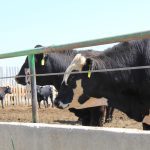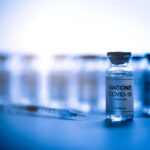Tag Archives vaccines

M. bovis, repeat offender
Police describe the suspect as being in his twenties with shaggy brown hair, wearing a black hoodie, white sneakers, blue jeans and a green backpack. He is known to associate with members of a criminal gang. If that was me, I’d be quick to cut my hair short, dye it gray, grow a distracting moustache […] Read more

The economics of preconditioning
Why aren’t more producers preconditioning calves? Kathy Larson dives into the research
Does preconditioning your calves pay? It has been a long-studied and debated topic. When it comes to preconditioning cattle, “every operation is different,” says Kathy Larson, research associate for the department of agricultural and resource economics at the University of Saskatchewan. Larson says there is opportunity for profit in preconditioning every year but it’s variable. […] Read more

Research into pain management and animal health
North American researchers are studying how pain mitigation affects the health and performance of calves, as well as the economics
Castration, and to a lesser extent dehorning, are routine and necessary procedures on cattle farms, ranches and feedlots across the nation. These stressful events deliver varying levels of concentrated pain to their recipients which fade over time but in doing so, also create extended ripples of influences throughout an animal’s life. Dr. Michael Jelinski of […] Read more

Vietnam approves commercial use of first African swine fever vaccines
U.S. Agriculture Secretary says farmers may purchase as precaution despite no domestic cases
Hanoi | Reuters – Vietnam has approved the domestic commercial use of two home-grown vaccines against African swine fever, the government said on Monday, making them the world’s first commercial vaccines against the deadly disease. The vaccines include NAVET-ASFVAC, co-developed by Navetco Central Veterinary Medicine and scientists from the United States, and AVAC ASF LIVE […] Read more

mRNA vaccines unlikely to replace common cattle vaccines, but could help contain foot-and-mouth disease in future
Vaccines have been a valuable tool to protect cattle health in North America, ever since the first blackleg vaccine was developed over a century ago. Ensuring the health of Canadian cattle is critical to maintaining consumer confidence, access to global livestock and beef markets and producer profitability. Vaccines help prevent infection and disease caused by […] Read more

Foot-and-mouth disease is a huge threat
Livestock producers across North America tremble when the name of a certain animal disease is mentioned. They know there has not been a case of the disease in the U.S. since 1929 and in Canada since 1952. But they know the disease is endemic in other countries and could enter the U.S. They also are […] Read more

Improving vaccination success in your beef herd
Get the most out of your vaccine investment by transporting, handling, storing and administering them properly
Vaccination is a proven management tool to reduce infectious disease risks in a beef herd — if the vaccine is effective in preventing and controlling the disease and the right vaccine is administered to the right cattle, at the right time, in the right way and at the right dose and frequency. Vaccination alone will […] Read more

Vaccines are cheap insurance — don’t let your premiums lapse
Research on the Record with Reynold Bergen
After last summer’s pasture conditions and last winter’s feed costs, it’s safe to say that many cow-calf producers are facing the upcoming grazing season with some anxiety. Some are looking for new grazing arrangements, opportunities to trim input costs or both. No single solution can solve every challenge for every operation, but nearly all decisions […] Read more

Being contrary is not caring
Vet Advice with Dr. Ron Clarke
The Canadian Veterinary Oath states the following: As a member of the veterinary medical profession, I solemnly swear that I will use my scientific knowledge and skills for the benefit of society. I will strive to: Promote animal health and welfare, Prevent and relieve animal suffering, Protect the health of the public and the environment, […] Read more

Livestock research a high priority for VIDO
COVID has highlighted the need to connect human and animal health, and for resources to address pandemics in either sphere
Canada’s ability to rapidly respond to emerging human and animal diseases was given a $59.2 million shot in the arm last fall in the federal budget, due to the pandemic. The funding is going to the University of Saskatchewan’s Vaccine and Infectious Disease Organization (VIDO). It, combined with $15 million from the province, $250,000 from […] Read more



